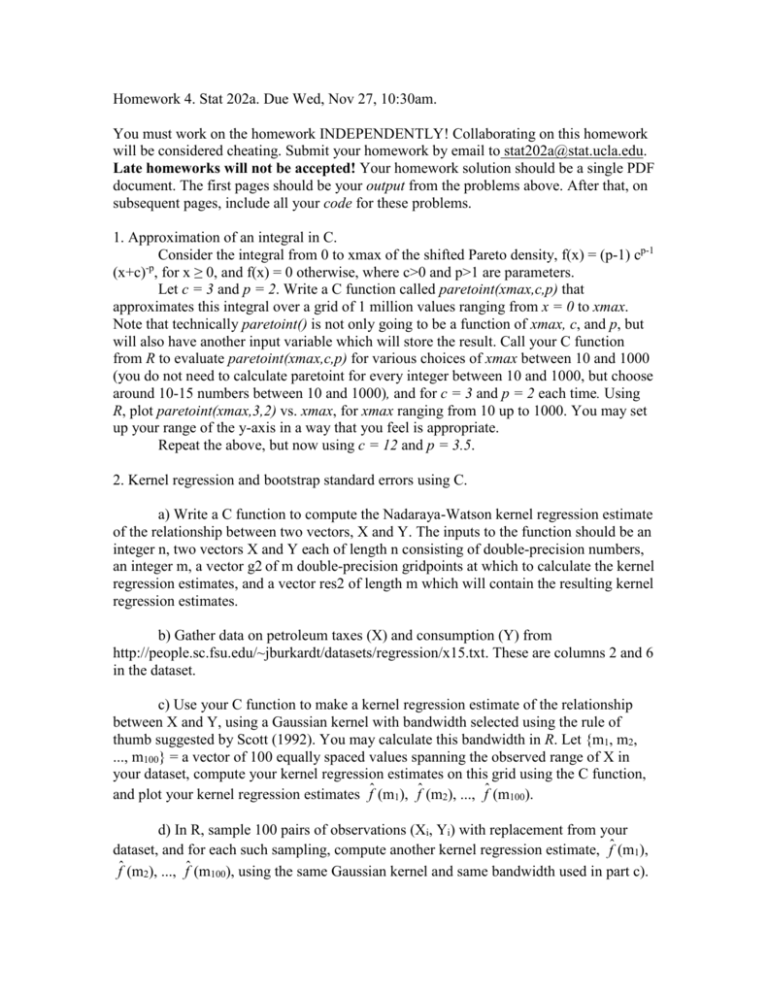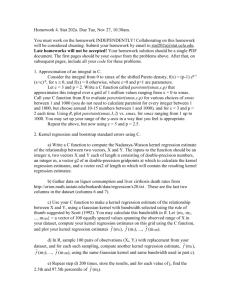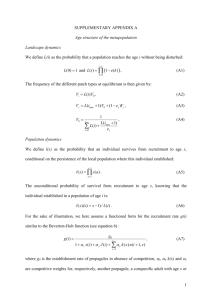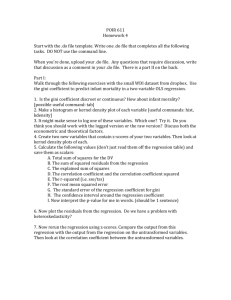hw4stat202a
advertisement

Homework 4. Stat 202a. Due Wed, Nov 27, 10:30am.
You must work on the homework INDEPENDENTLY! Collaborating on this homework
will be considered cheating. Submit your homework by email to stat202a@stat.ucla.edu.
Late homeworks will not be accepted! Your homework solution should be a single PDF
document. The first pages should be your output from the problems above. After that, on
subsequent pages, include all your code for these problems.
1. Approximation of an integral in C.
Consider the integral from 0 to xmax of the shifted Pareto density, f(x) = (p-1) cp-1
(x+c)-p, for x ≥ 0, and f(x) = 0 otherwise, where c>0 and p>1 are parameters.
Let c = 3 and p = 2. Write a C function called paretoint(xmax,c,p) that
approximates this integral over a grid of 1 million values ranging from x = 0 to xmax.
Note that technically paretoint() is not only going to be a function of xmax, c, and p, but
will also have another input variable which will store the result. Call your C function
from R to evaluate paretoint(xmax,c,p) for various choices of xmax between 10 and 1000
(you do not need to calculate paretoint for every integer between 10 and 1000, but choose
around 10-15 numbers between 10 and 1000), and for c = 3 and p = 2 each time. Using
R, plot paretoint(xmax,3,2) vs. xmax, for xmax ranging from 10 up to 1000. You may set
up your range of the y-axis in a way that you feel is appropriate.
Repeat the above, but now using c = 12 and p = 3.5.
2. Kernel regression and bootstrap standard errors using C.
a) Write a C function to compute the Nadaraya-Watson kernel regression estimate
of the relationship between two vectors, X and Y. The inputs to the function should be an
integer n, two vectors X and Y each of length n consisting of double-precision numbers,
an integer m, a vector g2 of m double-precision gridpoints at which to calculate the kernel
regression estimates, and a vector res2 of length m which will contain the resulting kernel
regression estimates.
b) Gather data on petroleum taxes (X) and consumption (Y) from
http://people.sc.fsu.edu/~jburkardt/datasets/regression/x15.txt. These are columns 2 and 6
in the dataset.
c) Use your C function to make a kernel regression estimate of the relationship
between X and Y, using a Gaussian kernel with bandwidth selected using the rule of
thumb suggested by Scott (1992). You may calculate this bandwidth in R. Let {m1, m2,
..., m100} = a vector of 100 equally spaced values spanning the observed range of X in
your dataset, compute your kernel regression estimates on this grid using the C function,
and plot your kernel regression estimates fˆ (m1), fˆ (m2), ..., fˆ (m100).
d) In R, sample 100 pairs of observations (Xi, Yi) with replacement from your
dataset, and for each such sampling, compute another kernel regression estimate, fˆ (m1),
fˆ (m2), ..., fˆ (m100), using the same Gaussian kernel and same bandwidth used in part c).
e) Repeat step d) 200 times, store the results, and for each value of j, find the
2.5th and 97.5th percentile of fˆ (mj).
f) Plot your kernel regression estimate from part c) using a solid line, along with
the 95% confidence bounds from part e), plotted using dotted lines, on the same plot.
Output: Your output for this assignment should be a pdf document containing the
following, in this order.
Figure 1. A plot of paretoint(xmax,3,2) vs. xmax, for xmax ranging from 10 to 1000.
Figure 2. A plot of paretoint(xmax,12,3.5) vs. xmax, for xmax between 10 and 1000.
Figure 3. A plot of your kernel regression estimates fˆ (m1), fˆ (m2), ..., fˆ (m100)
versus m, along with 95% bootstrap confidence intervals, for the petroleum tax and
consumption data.
After these 3 figures, include all of your Ccode, followed
byall of your R code.









